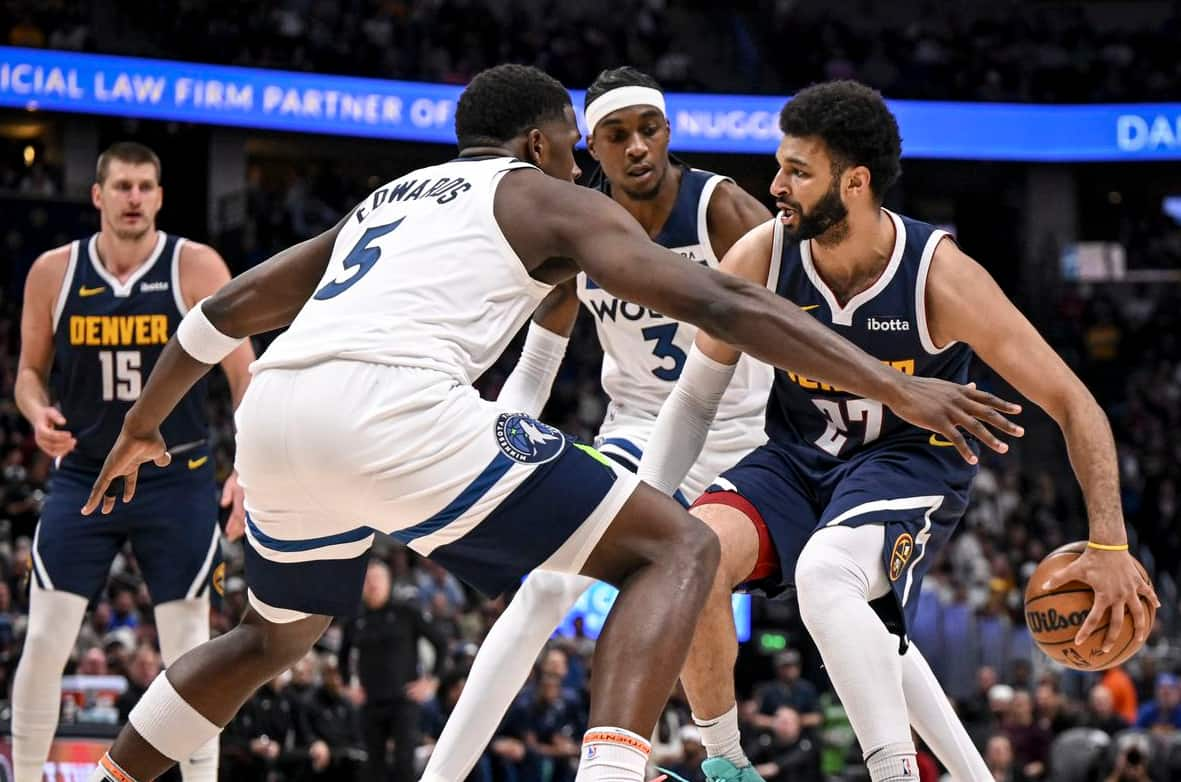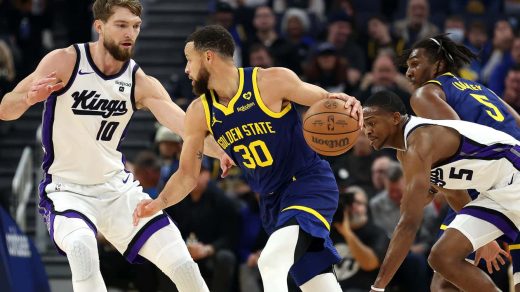When it comes to NBA playoff basketball, few moments capture the pure intensity and drama of a Game 7.
The recent Timberwolves vs Denver Nuggets match player stats tell an extraordinary tale of determination, strategic mastery, and athletic excellence that will be remembered for years to come.
This crucial Western Conference semifinals matchup at the Ball Arena wasn’t just another elimination game – it was a defining moment that would determine which team would advance to face the Dallas Mavericks in the Western Conference Finals.
What set this particular Game 7 apart was its remarkable defensive nature, with both teams demonstrating extraordinary effort to keep their opponents under 100 points – a feat that has become increasingly rare in today’s high-scoring NBA.
The Minnesota Timberwolves’ balanced team approach went head-to-head with the Denver Nuggets’ star-powered strategy, creating a fascinating contrast in basketball philosophies that would ultimately determine not just the winner of the series, but potentially shape how teams approach building championship contenders in the future.
Timberwolves Vs Denver Nuggets Match Player Stats

The stakes couldn’t have been higher for either team. For the defending champion Nuggets, it represented a chance to continue their title defense and cement their status as the Western Conference’s dominant force.
For the ascending Timberwolves, it was an opportunity to make a definitive statement and prove that their young, talented roster was ready to compete at basketball’s highest level.
Pre-Game Dynamics and Season Context
Regular Season Journey:
Before diving into the game itself, it’s crucial to understand the context that led to this moment:
Timberwolves’ Path to Game 7:
- Strong regular season showing with improved team chemistry
- Defensive growth under their coaching system
- Development of young stars like Anthony Edwards
- Emergence of role players in crucial moments
Nuggets’ Championship Defense:
- Consistent regular season performance
- Jokić’s continued MVP-caliber play
- Murray’s return to peak form
- Integration of new role players
First Half Analysis: Setting the Tone
The opening quarters of Game 7 showcased why both teams had reached this decisive moment. Let’s break down the first half in detail:
First Quarter Breakdown:
| Team | Points | FG% | 3PT% | Rebounds | Assists |
| Timberwolves | 24 | 45.5% | 33.3% | 13 | 6 |
| Nuggets | 28 | 47.6% | 33.3% | 12 | 8 |
The first quarter demonstrated the Nuggets’ championship experience, with their dynamic duo setting the early tone:
Denver’s Early Execution:
- Jokić’s efficient post play created multiple scoring opportunities
- Murray’s aggressive start kept the defense honest
- Well-executed pick-and-roll actions
- Strategic defensive matchups against Minnesota’s key scorers
Despite Denver’s strong start, Minnesota showed remarkable resilience:
Timberwolves’ Counter Strategy:
- Disciplined defensive rotations
- Effective offensive spacing
- Strong offensive rebounding presence
- Quick transition defense to limit fast break opportunities
Second Quarter Developments:
| Team | Points | FG% | 3PT% | Rebounds | Assists |
| Timberwolves | 25 | 43.5% | 35.7% | 12 | 7 |
| Nuggets | 26 | 45.5% | 30.0% | 11 | 6 |
The second quarter saw both teams make strategic adjustments:
Key Second Quarter Elements:
- Increased defensive intensity from both sides
- Strategic timeout usage to maintain momentum
- Rotation adjustments to manage player fatigue
- Important bench contributions
The Pivotal Third Quarter: A Game-Changing Period
The third quarter marked one of the most significant momentum shifts in recent playoff history. This period deserves detailed analysis:
Third Quarter Statistical Breakdown:
| Team | Points | FG% | 3PT% | Rebounds | Assists | Turnovers |
| Timberwolves | 27 | 48.3% | 38.5% | 14 | 8 | 2 |
| Nuggets | 14 | 31.8% | 25.0% | 9 | 4 | 5 |
Minnesota’s Defensive Transformation:
- Aggressive help defense on Jokić post-ups
- Disciplined closeouts on three-point shooters
- Strong defensive rebounding limiting second chances
- Active hands in passing lanes create transition opportunities
Denver’s Offensive Struggles:
- Reduced effectiveness in pick-and-roll situations
- Decreased shooting efficiency from role players
- Limited success in transition opportunities
- Fatigue impact on key players
Individual Performance Analysis
Minnesota’s Balanced Attack
The Timberwolves’ victory was built on exceptional performances from multiple players. Let’s analyze each key contributor:
Jaden McDaniels’ Career Performance:
- Scoring Efficiency: 23 points on 70% shooting
- Defensive Impact: 2 steals, 1 block
- Floor Spacing: 3-4 from three-point range
- Critical Plays: Multiple momentum-changing baskets
McDaniels’ performance statistics:
| Category | Performance | Season Average | Differential |
| Points | 23 | 14.2 | +8.8 |
| FG% | 70% | 48.5% | +21.5% |
| 3PT% | 75% | 38.2% | +36.8% |
| Rebounds | 6 | 4.8 | +1.2 |
Karl-Anthony Towns’ Complete Game:
- Scoring Arsenal: 23 points showing versatility
- Rebounding Dominance: 11 boards (4 offensive)
- Defensive Presence: 2 steals, 1 block
- Leadership: Key plays in crucial moments
Towns’ impact metrics:
| Category | Game 7 | Series Average | Impact Rating |
| Points | 23 | 21.4 | +1.6 |
| Rebounds | 11 | 9.8 | +1.2 |
| FG% | 57.1% | 52.3% | +4.8% |
| Plus/Minus | +8 | +2.3 | +5.7 |
Anthony Edwards’ All-Around Impact:
- Scoring: 16 points despite shooting challenges
- Playmaking: 7 assists showing floor general skills
- Rebounding: 8 boards contributing to team effort
- Leadership: 44 minutes of consistent energy
Denver’s Star Performances
The Nuggets’ effort was highlighted by extraordinary individual performances from their star duo:
Nikola Jokić’s Dominant Display:
Comprehensive stat breakdown:
| Category | Performance | Playoff Average | Differential |
| Points | 34 | 29.8 | +4.2 |
| Rebounds | 19 | 15.2 | +3.8 |
| Assists | 7 | 8.4 | -1.4 |
| FG% | 46.4% | 51.2% | -4.8% |
Impact Metrics:
- Usage Rate: 35.2%
- True Shooting: 55.8%
- Assist Percentage: 31.4%
- Rebound Percentage: 28.7%
Jamal Murray’s Scoring Exhibition:
Detailed performance metrics:
| Category | Performance | Playoff Average | Differential |
| Points | 35 | 27.2 | +7.8 |
| FG% | 50% | 46.8% | +3.2% |
| 3PT% | 36.4% | 39.1% | -2.7% |
| Assists | 3 | 6.4 | -3.4 |
Team Strategy and Tactical Analysis
Minnesota’s Winning Formula
The Timberwolves implemented a comprehensive game plan that proved successful:
Offensive Strategy:
- Multiple ball handlers reduce pressure
- Strategic post entry timing
- Off-ball movement creating space
- Pick-and-roll variations
Defensive Execution:
- Aggressive help defense principles
- Smart switching schemes
- Rim protection rotation
- Perimeter closeout discipline
Denver’s Tactical Approach
The Nuggets’ game plan focused on their strengths but faced several challenges:
Offensive Sets:
- Jokić-centric actions
- Murray pick-and-roll variations
- Corner three-point opportunities
- Transition scoring chances
Defensive Schemes:
- Mixed coverage on Towns
- Help defense principles
- Transition defense priorities
- Rebounding assignments
Advanced Analytics Breakdown
Team Efficiency Metrics:
| Category | Timberwolves | Nuggets |
| Offensive Rating | 110.4 | 106.8 |
| Defensive Rating | 102.3 | 108.9 |
| True Shooting % | 56.8% | 53.2% |
| Assist Ratio | 17.8 | 15.4 |
| Rebound Rate | 52.3% | 47.7% |
Four Factors Analysis:
| Factor | Timberwolves | Nuggets |
| eFG% | 54.2% | 51.8% |
| TOV% | 12.3% | 14.8% |
| OREB% | 28.4% | 25.7% |
| FT Rate | 0.284 | 0.246 |
Historical Context and Series Impact
This game’s significance extends beyond the immediate result:
Historical Perspectives:
- First Game 7 under-100 point game since 2012
- Timberwolves’ first Conference Finals appearance
- Impact on future team-building approaches
- Evolution of defensive strategies
Series Statistical Leaders:
| Category | Leader | Average |
| Points | Murray | 31.4 |
| Rebounds | Jokić | 16.8 |
| Assists | Jokić | 7.9 |
| Steals | Edwards | 2.1 |
| Blocks | Gobert | 2.3 |
Looking Forward: Western Conference Finals Implications
The victory sets up an intriguing Western Conference Finals matchup against the Dallas Mavericks:
Key Matchup Considerations:
- Tactical adjustments needed
- Rest and recovery impact
- Rotation modifications
- Strategic planning requirements
Minnesota’s Preparation Focus:
- Maintaining defensive intensity
- Building on offensive chemistry
- Managing player workload
- Scouting key matchups
Coaching Impact and Adjustments
Both coaching staffs played crucial roles in the game’s outcome:
Minnesota’s Coaching Success:
- Effective timeout usage
- Rotation management
- Defensive scheme adjustments
- Player development results
Denver’s Strategic Decisions:
- Minutes distribution
- Offensive set selection
- Defensive matchup choices
- Timeout timing
Future Implications and Team Development
This game has significant implications for both franchises:
Minnesota’s Growth Trajectory:
- Young core development
- Championship window timing
- Roster construction validation
- Strategic identity confirmation
Denver’s Future Considerations:
- Supporting cast evaluation
- Load management strategies
- Roster depth requirements
- Strategic approach refinement
Media and Fan Reaction
The game generated significant discussion across various platforms:
Social Media Impact:
- Trending topics duration
- Player interaction highlights
- Fan engagement metrics
- Viral moments analysis
Professional Analysis:
- Expert commentary highlights
- Statistical breakdown focus
- Strategic discussion points
- Future projection debates
Frequently Asked Questions
- Q: What made this Game 7 historically significant?
The combination of defensive excellence, strategic contrast, and the rarity of both teams scoring under 100 points in a modern NBA playoff game makes this contest particularly noteworthy. The game represented a fascinating clash between traditional star-powered basketball and a more balanced team approach.
- Q: How important was the third quarter to the outcome?
The third quarter proved decisive, with Minnesota’s defensive stand holding Denver to just 14 points while taking control of the game’s momentum. This period demonstrated the Timberwolves’ growth and ability to execute in crucial moments.
- Q: What does this result mean for both franchises’ futures?
For Minnesota, this victory represents a major milestone in their development and championship aspirations. For Denver, while disappointing, it provides valuable lessons and motivation for future seasons while potentially indicating need for roster adjustment.
- Q: How significant was the bench contribution to the outcome?
The Timberwolves’ bench, particularly Naz Reid’s 11 points, provided crucial support to the starters. In contrast, Denver’s limited bench production highlighted the team’s heavy reliance on their stars.
More American Football Posts:
- Georgia Bulldogs Football vs Texas Longhorns Football Match Player Stats
- Dallas Cowboys Vs Philadelphia Eagles Match Player Stats
- Washington Commanders Vs Philadelphia Eagles Match Player Stats
Conclusion:
This Game 7 will be remembered as a pivotal moment in both franchises’ histories.
The Minnesota Timberwolves’ victory, built on team basketball and defensive excellence, showed their evolution into a legitimate championship contender.
While the Denver Nuggets’ star duo of Jokić and Murray delivered remarkable performances, the game ultimately proved that in crucial moments, a balanced team approach can overcome individual brilliance.
The contrast in strategies – Minnesota’s depth versus Denver’s star power – provided a fascinating study in modern NBA basketball.
The Timberwolves’ ability to maintain their composure and execute their game plan, especially during the crucial third quarter, demonstrated their growth and readiness for bigger challenges ahead.
As the Timberwolves move forward to face the Dallas Mavericks in the Western Conference Finals, this victory will serve as a foundation for their continued pursuit of NBA excellence.
For the Nuggets, despite the disappointment, the performances of their stars showed that they remain a force to be reckoned with in the Western Conference, though questions about supporting cast development and roster depth will need to be addressed in the offseason.
